Jerusalem – The Old City, Excavations
Day Three - Wednesday July 5th 2006 -  - Yom
Rivee-ee
- Yom
Rivee-ee
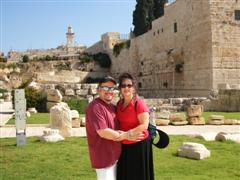 Today we took a tour located near the South
Western wall in a beautiful garden. The tour (of which part was a computer
animated “flyover” of the Temple including close-ups of the people you
would typically find on the street) was of the history of the temple
focusing on the architecture of the King Herod days. Today we took a tour located near the South
Western wall in a beautiful garden. The tour (of which part was a computer
animated “flyover” of the Temple including close-ups of the people you
would typically find on the street) was of the history of the temple
focusing on the architecture of the King Herod days.
The South West corner
had a remarkable archway that extended some 42 meters from the temple, all
destroyed by the Romans in 70 CE. Through excavations, they have uncovered
the market area during the Herodian times (King Herod, a Jew by birth,
appointed by the Romans to rule) where you would be able to exchange money
at the temple (it cost ½ shekel to enter the temple back then), buy
your sacrifice, or shop for a few other items. This discovery is more
recent and was underground for nearly 2000 years.
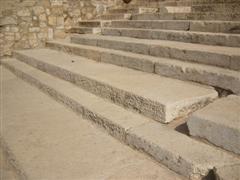 The steps leading to
the temple were an alternating pattern of wide and narrow steps.
They were designed this way to force people to slow down when ascending the steps of the
temple to show the proper respect. The steps on the Southern wall are
still there, I climbed all of them. The steps leading to
the temple were an alternating pattern of wide and narrow steps.
They were designed this way to force people to slow down when ascending the steps of the
temple to show the proper respect. The steps on the Southern wall are
still there, I climbed all of them.
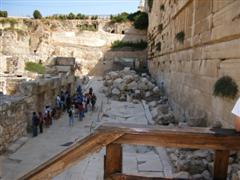 The
view from the south-west corner of the temple mount is quite
astounding. As you look North, towards the location of the
"wailing wall," you can see where the excavations have taken
place over the last few years to reveal this Herodian plaza (see right) at the base of
the temple wall. The vertical excavation site shows you how the
history was created/revealed in stages. As you dig down 10 feet, you
reveal history from 500 years ago, as you dig down 30 feet, you reveal
history from 1000 years ago, etc. There is nothing like this in
America to compare it to. This remarkable city had been built up,
destroyed, rebuilt, re-destroyed, and rebuilt again. Restoration and
archeology were apparently not practiced (or cared for) until the 19th and
20th centuries. The
view from the south-west corner of the temple mount is quite
astounding. As you look North, towards the location of the
"wailing wall," you can see where the excavations have taken
place over the last few years to reveal this Herodian plaza (see right) at the base of
the temple wall. The vertical excavation site shows you how the
history was created/revealed in stages. As you dig down 10 feet, you
reveal history from 500 years ago, as you dig down 30 feet, you reveal
history from 1000 years ago, etc. There is nothing like this in
America to compare it to. This remarkable city had been built up,
destroyed, rebuilt, re-destroyed, and rebuilt again. Restoration and
archeology were apparently not practiced (or cared for) until the 19th and
20th centuries.
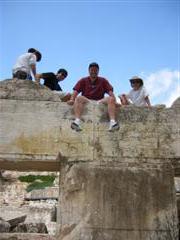 I also climbed up to the top of the area
where the merchants shops are with Mike, Chris and Sam (the young guys).
We had pictures taken, the Rabbi didn’t seem happy with our decision to
climb up, as it is an archeological site. Still, it felt great to act like
a kid again! Sorry Rabbi! :-) I also climbed up to the top of the area
where the merchants shops are with Mike, Chris and Sam (the young guys).
We had pictures taken, the Rabbi didn’t seem happy with our decision to
climb up, as it is an archeological site. Still, it felt great to act like
a kid again! Sorry Rabbi! :-)
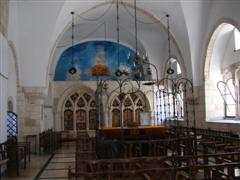 We then walked up the western wall to reach the Jaffa gate. We visited several Sephardic synagogues and studied some of the differences between Sephardic and Ashkenazick traditions. Though the Tenach is the same, the cover for the torah in a Sephardic temple is wooden and the torah is not removed, it is read as it sits straight up in the air. We then walked up the western wall to reach the Jaffa gate. We visited several Sephardic synagogues and studied some of the differences between Sephardic and Ashkenazick traditions. Though the Tenach is the same, the cover for the torah in a Sephardic temple is wooden and the torah is not removed, it is read as it sits straight up in the air.
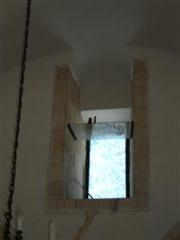 In
one of the synagogues, there was a wine decanter and a challah plate that
sat high up on a glass shelf. It was said that when moshiach (the
messiah) comes, he will pass through this sanctuary on his way to THE
temple, and they would be ready to say the blessings over the wine and
bread during shabbos with moshiach. I doubt that there is any
wine in the decanter. Then again, maybe Gadi was joking
around. Actually, he probably was! In
one of the synagogues, there was a wine decanter and a challah plate that
sat high up on a glass shelf. It was said that when moshiach (the
messiah) comes, he will pass through this sanctuary on his way to THE
temple, and they would be ready to say the blessings over the wine and
bread during shabbos with moshiach. I doubt that there is any
wine in the decanter. Then again, maybe Gadi was joking
around. Actually, he probably was!
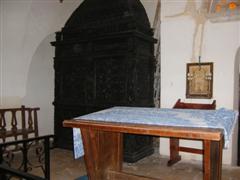 We then
discovered that we lost Judy Crocker. Contrary to all of the worrying, she went on to the next item on the itinerary and wondered where we went and why we were worried. She took it quite well considering the group left her.
We later spent a lot of time with, and got to know Judy. If this would have been later in the trip, no one would have batted an eye! We then
discovered that we lost Judy Crocker. Contrary to all of the worrying, she went on to the next item on the itinerary and wondered where we went and why we were worried. She took it quite well considering the group left her.
We later spent a lot of time with, and got to know Judy. If this would have been later in the trip, no one would have batted an eye!
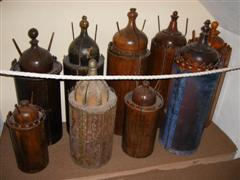 We went on to a couple of museums focusing
on the fight between the Jordanians and the Jews in May of 1948 where the
Jews lost control of the Jewish Quarter of the Old City (including the
Kotel) only to be restored in the 1967 war. The Jews were forced from
their homes, many temples were destroyed, torahs were stolen and the
Jordanians didn’t rebuild this area (from nearly utter destruction)
until the early 1960’s. We went on to a couple of museums focusing
on the fight between the Jordanians and the Jews in May of 1948 where the
Jews lost control of the Jewish Quarter of the Old City (including the
Kotel) only to be restored in the 1967 war. The Jews were forced from
their homes, many temples were destroyed, torahs were stolen and the
Jordanians didn’t rebuild this area (from nearly utter destruction)
until the early 1960’s.
A factoid I learned: The temple mount is
under complete control of the Arabs. Moshe Dyan had the opportunity to
regain this area after the 67 war, I suppose as a “spoil” of war, but
decided NOT to do this. Gadi said it was/is considered a monumental
mistake. Jews don’t have a single foothold of the temple mount, it is
completely Arab controlled.
We ate lunch at a pizza joint in the Old
City. I almost bought from an Arab vendor, as all vendors kind of looked
the same, but alas, I did purchase from a Jewish vendor. It was
important for two reasons: First I wanted to support the Jews, not
the Arabs, and secondly, I had eaten nothing but kosher food up until that
point, and the Arab vendor's kitchen was not a proper kosher kitchen.
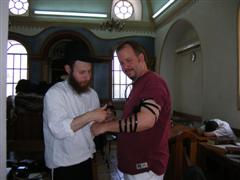 Afterwards we went to the Chabad house, where I met Chaim who helped
me put on Tefilin. I said the Shema and spoke with him for a few minutes.
His English was a bit broken, but he was very nice and made me feel
welcome, no pressure. Afterwards we went to the Chabad house, where I met Chaim who helped
me put on Tefilin. I said the Shema and spoke with him for a few minutes.
His English was a bit broken, but he was very nice and made me feel
welcome, no pressure.
The funny thing is, we had been hounded by this one
particular (orthodox looking) guy for money several times over the last
day. He had approached us no less than 4 times for charity. We turned him
away each time as he was pushy. When we went into the Chabad house,
at first, we went into a room where a bunch of Chabad men where eating
lunch. The first one that I saw in the room was this guy! He said, “come
in, eat some lunch with us.” I had already felt uncomfortable around
this guy, so I (we) declined and asked where we could put on tefilin. He
motioned "upstairs."
 Imagine, one minute you have a beggar asking you for money and the next
minute he is offering you lunch! Right after taking this particular
picture of him (to the right), he attempted again to chase me down for some
charity, I must have had "sucker" stamped on my head.
Please note how had to get off of his cell phone call to beg! Imagine, one minute you have a beggar asking you for money and the next
minute he is offering you lunch! Right after taking this particular
picture of him (to the right), he attempted again to chase me down for some
charity, I must have had "sucker" stamped on my head.
Please note how had to get off of his cell phone call to beg!
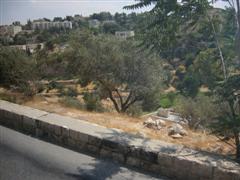 On the way out to taking a walking tour of
some of the other settlements outside the Old City, we passed the “gateway
to hell” a valley called Gan Hedon, or in English Gan-adin. It actually
exists! It doesn’t look like it’s reputation, it was kind of nice,
with a park in it. On the way out to taking a walking tour of
some of the other settlements outside the Old City, we passed the “gateway
to hell” a valley called Gan Hedon, or in English Gan-adin. It actually
exists! It doesn’t look like it’s reputation, it was kind of nice,
with a park in it.
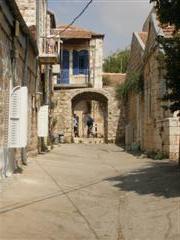 During our walking tour, we saw the many settlements of people such as the Armenians, Sephardis, Yemenites, Syrians, etc. We saw some college oriented communities, some newly renovated homes. People typically have their hot water heater on their roofs to heat water up for free from the sun. During our walking tour, we saw the many settlements of people such as the Armenians, Sephardis, Yemenites, Syrians, etc. We saw some college oriented communities, some newly renovated homes. People typically have their hot water heater on their roofs to heat water up for free from the sun.
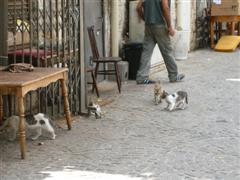 We saw a bunch of stray cats, they were all
over the place. We even saw a cat fight! We stood on the edge of Nashlaot an orthodox part of town,
but didn’t go in since some of the women were dressed “inappropriately”
meaning that they didn’t have their shoulders covered. We saw a bunch of stray cats, they were all
over the place. We even saw a cat fight! We stood on the edge of Nashlaot an orthodox part of town,
but didn’t go in since some of the women were dressed “inappropriately”
meaning that they didn’t have their shoulders covered.
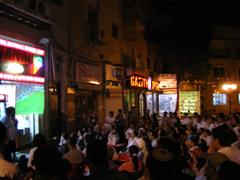 We came back to the
Dan Panorama hotel and
took in a 20 minute swim. Judy was there. The water was cold and we decided to go back to
the room. I showered and we took a 2 hour nap. When we woke, we went to
Little Italy for dinner across from the hotel. We had vouchers since we
weren’t going to be with the group the following night. The food was
good and bountiful, it was a milchadic restaurant. We then took a walk all the way up to Ben Yahuda
street and took in the sites and sounds of a vibrant young Jerusalem
community. The people here were out walking around enjoying the evening,
shopping and a huge group of maybe 200 people outside watching the world
cup game of France vs. Portugal. Nearly everyone (including many Yeshiva
“looking” students) was rooting for France, I’m not sure why, as the
French have no love of Jews. We came back to the
Dan Panorama hotel and
took in a 20 minute swim. Judy was there. The water was cold and we decided to go back to
the room. I showered and we took a 2 hour nap. When we woke, we went to
Little Italy for dinner across from the hotel. We had vouchers since we
weren’t going to be with the group the following night. The food was
good and bountiful, it was a milchadic restaurant. We then took a walk all the way up to Ben Yahuda
street and took in the sites and sounds of a vibrant young Jerusalem
community. The people here were out walking around enjoying the evening,
shopping and a huge group of maybe 200 people outside watching the world
cup game of France vs. Portugal. Nearly everyone (including many Yeshiva
“looking” students) was rooting for France, I’m not sure why, as the
French have no love of Jews.
Thought: I feel that Jerusalem is a very “tolerant”
city. There are people of all religions here. Each religion is free to
worship as they please. There are mosques, temples, churches, all under
the jurisdiction of the Israeli government. We have the same in America,
what makes this more tolerant is that they have the tolerance regardless
of the incredible tensions which constantly put Israel’s patience to the
test.
This is more of an education rather than a vacation!
We bumped into Michael and Marci Mostofsky,
Paula Flax Carl’s sister - again. I told Michael of the archeological
museum, he told me of how an inscription in the rock of the Western side
of the temple was at eye level when he last went. That inscription is now
over 20 feet high, due to the excavation.
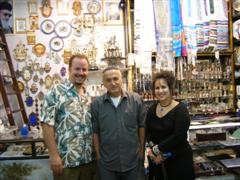 The shops had signs on them, thanking us, as
travelers to Israel, for being courageous to come to Israel and support
them. Although I didn’t feel courageous, I appreciated their gratitude.
Later I found out that those signs had been there since the intifada in
2000. Then we found a shop and bought Jewish Tevia characters from Yoshiaho. I
remarked to him of how beautiful the second temple must have been, and how it
upsets me that the Arabs have complete control of the temple mount. He
said (in broken English with a very heavy accent) that the Jewish people
are basically happy and we “play,” but we are like the young boy, who
loses his mother at a young age. He is out playing and is happy, yet has
no idea of the scope of what he lost. So too are we, like the child, we
can’t conceptualize the magnitude of this incredible loss. The shops had signs on them, thanking us, as
travelers to Israel, for being courageous to come to Israel and support
them. Although I didn’t feel courageous, I appreciated their gratitude.
Later I found out that those signs had been there since the intifada in
2000. Then we found a shop and bought Jewish Tevia characters from Yoshiaho. I
remarked to him of how beautiful the second temple must have been, and how it
upsets me that the Arabs have complete control of the temple mount. He
said (in broken English with a very heavy accent) that the Jewish people
are basically happy and we “play,” but we are like the young boy, who
loses his mother at a young age. He is out playing and is happy, yet has
no idea of the scope of what he lost. So too are we, like the child, we
can’t conceptualize the magnitude of this incredible loss.
Thought: Jerusalem is really like any other city, it is very much the same. People here want to watch soccer games, drink a beer, they bank, they use cell phones, they want to get from A to B as fast as possible, and they drive and beep at each other. At the end of the day, we are all the same, what makes people different is politics and religion, the very things that
affect people in such a way as to wake up their emotions. The rest is mostly physical, race, gender, strength etc. For people to really understand each other would require an exercise in keeping their emotions under control.
Thought: I’ve been wearing my Yarlmuke the
whole time and the funny thing is, I look so non-Jewish!
We walked back to the hotel and called it another great day!
[ Back ] [ Up ] [ Next ]
|